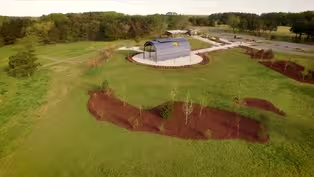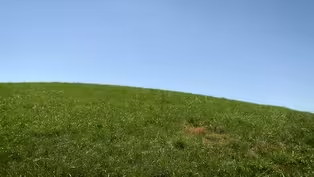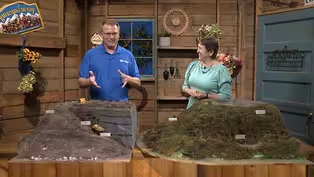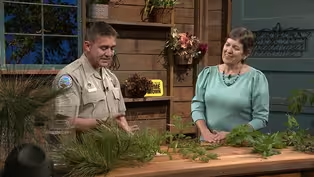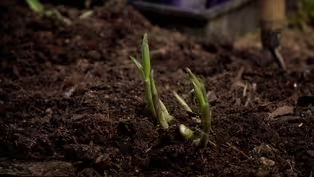Virginia Home Grown
Clippings: Land Management
Clip: Season 23 Episode 2 | 26m 46sVideo has Closed Captions
Learn about efforts to protect and restore natural areas in Virginia!
Peggy Singlemann visits Kyanite Mining Corporation to learn about the company’s industry-leading approach to environmental stewardship. Amyrose Foll tours Machicomoco State Park, where ranger Terry Sims explains the plan for ecological succession at the park. Shana Williams and Serome Hamlin share garden tips. Engage with us or watch full episodes at vpm.org/vhg.
Problems playing video? | Closed Captioning Feedback
Problems playing video? | Closed Captioning Feedback
Virginia Home Grown is a local public television program presented by VPM
Virginia Home Grown
Clippings: Land Management
Clip: Season 23 Episode 2 | 26m 46sVideo has Closed Captions
Peggy Singlemann visits Kyanite Mining Corporation to learn about the company’s industry-leading approach to environmental stewardship. Amyrose Foll tours Machicomoco State Park, where ranger Terry Sims explains the plan for ecological succession at the park. Shana Williams and Serome Hamlin share garden tips. Engage with us or watch full episodes at vpm.org/vhg.
Problems playing video? | Closed Captioning Feedback
How to Watch Virginia Home Grown
Virginia Home Grown is available to stream on pbs.org and the free PBS App, available on iPhone, Apple TV, Android TV, Android smartphones, Amazon Fire TV, Amazon Fire Tablet, Roku, Samsung Smart TV, and Vizio.
Providing Support for PBS.org
Learn Moreabout PBS online sponsorship(birds twittering) >>You know, we live here, not just my family but every family that works here, and we have to breathe this air and swim in these creeks and fish in the ponds around here.
These reclamation projects are the right thing to do.
>>As you travel through the entire park and our interpretive area here, you'll find unique little features that kind of help you see the beauty of this land and then kind of the story of the indigenous peoples that once lived here.
>>Production funding for "Virginia Home Grown" is made possible by.
(birds chirping) (upbeat music) Welcome to Virginia Home Grown.
Today we are looking at land management in Virginia.
How sites are conserved, protected and restored.
Amyrose Foll visited Gloucester County to tour Machicomoco State Park, the Commonwealth's first state Park dedicated to honoring Native American history and culture.
She met Ranger Terry Sims to learn how the property is managed and to explore the various habitats the park protects.
(birds chirping) >>It's beautiful here.
Can you tell me a little bit about this place and the history of it and its significance?
>>Welcome to Machicomo co State Park.
We're here in Gloucester, Virginia.
Here at this park, we have over 645 acres that the state manages.
Right now we are standing in our interpretive area.
And this is a really beautiful area to come whenever you come out to the park.
We have beautiful view sheds and we have a lot of history that we have on display.
>>When did this site open?
>>Well, this site opened on April 16th of 2021.
>>What does Machicomoco mean?
>>Machicomoco, excellent question.
That is Algonquin language, which means a special meeting place.
It got its name from the committee that was on the design team.
The indigenous peoples of Virginia got together and came up with the name.
>>Can you tell me a little bit about how you are incorporating that into the management and preservation and conservation of this area?
>>Well, our mission here is to, obviously with state parks, we preserve and conserve the lands that we look after.
And here at this park, it's truly a unique one 'cause we were dedicated to help support the, in telling the stories of the indigenous peoples that lived here and continue to live here in the Senecamaca region.
>>So does that story include Powhatan that we all know?
How does that play into this?
>>Well Powhatan, if you travel 10 miles upstream, that is the Werowocomoco, that is the the capital of the Powhatan chiefdom.
That is where the paramount chief set.
>>I see you have a lot of native plants incorporated into your conservation and land management practices here.
What are the significance of these plants to the interpretive center at this site?
>>Right, the plants that you'll find here whenever you visit the interpretive area have a lot of special use and cultural meaning to the indigenous peoples of the day.
A lot of it is medicinal, some structural uses.
Some of the plants are the inkberries.
We have some switchgrass, little bluestem, many different different species you'll find here at the park.
>>How do those work in conjunction with the structure that you have here?
Can you tell me what that is?
>>Well, the structure behind us is a modern interpretation of a yi-hakan.
Yi-hakan is another Algonquin word that means a long house.
So that was the homes that the indigenous peoples lived in.
So the bone structures of the yi-hakan is actually made out of the black locust, of which that is what the typical tree that would've, they would've used for the studs of the home.
>>Very nice.
Tell me more about the other things we see here.
What's behind us?
>>Of course, as you go down the path to the west of the yi-hakan, you'll come across a map of Senecamaca, which is the region that we're in.
That map is made up of a Virginia mist granite.
It has some unique features and key points that is marked on the map to kind of tell you important features, like where the indigenous tribes live today, and then some other key areas in Virginia.
>>That's great.
Let's see more of the park.
>>Perfect.
Let's go for a hike.
(birds calling) >>Tell me a little bit about this.
What is this?
>>This is our history timeline.
As you walk down the timeline, you'll come across some different points throughout history that were key to the indigenous peoples.
So here at Machicomoco, we have over six miles of trails.
Right now we're on the interpretive trail.
We're gonna head over to the forestry trail where we're going to be taken to a more natural area.
Over there we'll see more views of the Catlett Islands and the waterways.
>>This is beautiful.
(gravel crunching) (water gurgling) (insects chirping) >>This is a really excellent place for bird habitats.
This year we have more than 160 different bird species.
>>Oh wow.
(birds chirping) So we saw a lot of different kinds of habitat here.
Can you tell me more about what we've seen?
>>Yeah, that's one of the amazing things here at Machicomoco is we have such a diverse habitat.
As we walk past this pathway here at the cartop kayak launch, you can kind of see those transitions.
From the road, there's the ag field, then you have the tall grass, then you have the taller shrubs, and then as we're walking into the more mature trees here.
So it's a great experience to kind of actually see the ecological succession that happens.
>>That's wonderful that you are intentionally creating plans to preserve this area for future generations.
Is it a long-term plan that you work on?
>>Right now we are in the process of planning out our long-term vision here.
What we'll do there is just kinda look at an aerial view of the property that we're managing, and determine the resources that are there, and then figure out which areas that we want to kind let grow back up into maybe a more mature forest, or maybe keep as a grassland.
So it'll be a lot of park rangers kind of getting together and kind of coming up with the best opportunity here.
>>So what are we seeing here?
>>Oh, this is an amazing spot to come.
This is our boardwalk, which leads out to a really nice cartop kayak launch.
And then the view shed is just amazing.
This is Poplar Creek here, and out there just on the other side of the creek is the Catlett Islands.
Just beyond the islands is the York River, of which back in the day was the Pamunkey River.
What we do here with the watershed is we provide kayaking opportunities, and then also some bird watching.
Off of the islands over here you can get a glimpse of one of the eagle's nests that was active last year.
We had two eaglets born.
>>I'm so glad that you're doing this for the residents of Virginia.
This is a really special place.
>>One of the great things with working with state parks is that, not only do we conserve and preserve the land that we manage, but we also offer recreational and educational opportunities for people to come out and kind of learn about the land and just kind of enjoy it as well.
And so yeah, it's an amazing opportunity.
>>It is amazing.
Thank you so much for having me out today.
>>Yeah, well thank you for coming.
You definitely brought a beautiful day with you.
Machicomoco is one of Virginia's newest state parks, and I look forward to seeing how the property evolves.
They're off to a great start, conserving a unique, historic and ecological site.
I plan to visit the park with my kayak soon.
And next, Shana Williams has tips to share on how you can protect the soil and conserve water in your vegetable garden with woodchips.
(jaunty music) >>We are now at the garden, and this is our small garden, but we wanna talk about helping you to conserve water and protect the land.
So one of the things that I like to do is, I like to use wood chips.
What I will do is I'll get some wood chips, find someone who's cutting down trees, and ask them, "Can you dump a load of wood chips in my yard for me?"
And what I'll do is I'll take some of this cardboard, make sure that I remove all the tape off of it, place it down on the ground, take some wood chips, a lot more than this, of course, and then start tossing it onto our cardboard.
But as you know, we don't always get all the weeds, so often we might have different things growing along the side.
We have to pull those up.
And if you notice, hey, these are scallions.
I gotta hold on to some of these and use these later.
I have our regular type of wood chips here, which are just freshly cut, and I like to put those on our walkway.
And then I'll have some aged wood chips here.
Those sat around for about a year, and often I might mix in some manure.
But the key thing about this is these wood chips will help me do several things in my garden.
They will help eliminate soil erosion.
So as the wind continues to blow, what happens is my soil dries out and it starts to blow around, of course, and over time, I have decreased soil.
So as I add wood chips, that'll help keep my soil in place, but another key thing that it's going to do for me is allow my soil to stay moist between waterings.
So as I water in my garden and water in my plants fairly well and as the rainwater, guess what, my soil, my roots, they'll still stay moist because the wood chips are allowing a lot of that moisture to stay in the soil, and over time, guess what's going to happen?
My plants are going to be happy because they're going to have a lot of the moisture that they need and I get to be happy because I get to water less often.
Happy gardening.
Being more water wise in the garden is something we should all strive for.
And mulching is an easy step to take toward this goal.
I too mulch with wood chips along with other organic materials such as leaves, pine tags and straw.
And now let's visit Kyanite Mining Corporation in Buckingham County.
To see their award winning land reclamation site and learn more about how mined land is restored to a natural state, which begins when the first blade hits the ground.
>>Gentlemen, I have never been on a reclaimed mine site.
You know, I think of mine sites as open and barren areas.
But I've also never heard of Kyanite.
So, I've got so many questions to ask.
So, let's ask the obvious one.
Guy, what is kyanite?
>>Kyanite is a ceramic raw material that is useful for its high melting point and other heat-resistant properties.
>>And how did Kyanite Mining Company come about?
>>Kyanite Mining Corporation was founded in the mid 1940s, when my grandfather and great-grandfather bought the predecessor mine which had gone bankrupt several times during the Great Depression and tried to make a go of it right at the end of the Second World War.
>>So, is this the original mine that was purchased back then?
>>No, the original mine is located about 20 or 30 miles south of here as the crow flies at a place called Baker Mountain, which was the sole mining location for the company up until the early 1950s when they started this location up.
>>Okay, so they mined this location for how many years in this exact location we're standing at before the restoration started?
>>There was no actual mining going on right here where we are.
The mining takes place on that hill that you can see in the background, and a hill over that way, which you can't really see right here.
Where we're standing here is a deposit for all of the various mineral constituencies that are mined that aren't kyanite and that we have to do something with.
And so we're kind of moving the mountain from over there, over here.
>>We're standing on a new mountain.
>>That's right, that's right.
>>That's fantastic.
So, John, how do you start the process of reclaiming a barren mountain?
>>Peggy, our overarching goal is to ensure that no sediment leaves our site.
So, our first step is to create sediment control structures like sediment dams, rock filter berms, diversion ditches so if erosion occurs we can capture that sediment in these structures and prevent it from leaving our site.
And then those minerals that we don't sell as kyanite product, or a byproduct, start to be deposited behind that sediment dam.
And as that elevation increases, we spread topsoil on those layers, creating the grassy slope that we're standing on now.
>>So, what is that seed mixture?
And how do you determine that mixture?
>>Great question.
Our mixture is approved every year by the state of Virginia's Department of Energy.
And that typical mixture includes fescue, clover, lespedeza, and whatever cover crop we might choose for that time of planting.
As you can see, a lot of our site is slope-driven.
And so our seeding needs to be respective of that slope.
And our goal is to ensure that as soon as we apply that seed and that fertilizer mix, that the seed sprouts and holds that soil in place.
Remember I lead with, we don't want any erosion of our reclamation site.
So, our mix is designed to sprout very quickly, hold that topsoil in place and allow for the perpetual use by our wildlife.
>>So, you've put down basically an annual rye first because that, to me, is the fastest way to hold the slope immediately.
>>It is, and that comes up immediately, to your point.
But then the fescue and the clover and the lespedeza isn't far behind.
And that stabilizes the soil, while also to the clover mix, enriches the soil as years go on.
>>Yes.
Do you have to do any soil testing and any modifications of the soil while you're getting this space established?
>>We do soil sampling before we apply our seed and fertilizer and lime mix so that we know what that mix should be.
Our seed mix stays the same, but our fertilizer and our lime applications vary by what those soil samples recommend.
So, we might be seeding an acre or two at a time, maybe three or four acres.
And if the number is that high, three or four acres, we'll probably take three or four or five soil samples just in case there are areas within that topsoil spread that require a little more fertilizer or a little less lime.
>>Yes.
So, you're able to fine tune it.
You're just not blindly broadcasting things.
>>That's exactly right.
>>That is so good to hear.
Warms my heart.
But you also mentioned wildlife.
So, do you do any additional seeding to bring in more of the wildlife?
>>Great question.
So, we spoke with a wise horticulturalist just last week who suggested that in addition to the soil stabilization that our original seed mix supplies, we add in some native grasses and some native wildflowers so that as this site progresses into Mother Nature retaking it, it's hosting those native grasses and those native wildflowers.
So, our seed mix now and forevermore includes a native grass and a native wildflower mix.
>>Thank you, I appreciate it.
>>You're very welcome.
Thanks for the advice.
>>You're welcome.
But how long will you keep managing the site before you do let it go to Mother Nature?
>>We like to manage our sites for many years, I would say close to a decade after we create them to ensure that there is no differential settling, no erosion taking place on a section of grass that didn't come up as well as we had expected.
And that way, if we have to go back and make a patch here or there, we're not disturbing trees that might have sprouted.
And then once we're sure that the water is going where it should go, there's no erosion, that the seed mix is doing its job, then we will by all means let Mother Nature run its course.
>>I'm just so impressed by all the work that's here.
But, Guy, what prompted your family to initiate reclaiming the property, the land?
>>Well, that's a really important question.
It's just the right thing to do.
And so that's, in its essence, why we do it.
And there's lots of things about being part of a community that make you do various things.
And these reclamation projects are one of those.
But there's all kinds of ways that this company is involved in the community.
We're very active in supporting emergency services, which in a rural place like this, the volunteer fire departments and the volunteer rescue squads need all the help they can get.
And we're honored to be able to help.
To little things, like we have a trash pickup day where we get the whole company, give them the day off and pick up hundreds of bags of trash.
And so it's all those kinds of things wrapped into one.
But it all comes back to the fact that we all live here and are part of these communities.
And it's home, and you treat it like home.
>>I applaud you for doing that.
Because having the company be just part of the community and the community then becomes part of the company.
And there's a pride.
And I congratulate you.
>>Thank you.
>>Well, I understand from all of this hard work that you have done that you've won many awards.
>>Yes, we have.
And that's a point of serious pride for me and John and everybody who works here.
This is the latest project that we've done that we've won an award for.
I believe we've won the State of Virginia Best Reclamation Award here.
And we might be in the running, John knows better than I do, for a national award here.
And we have actually won quite a few state awards in the past and even two national awards for the original mine, Baker Mountain, brought back to a state of nature.
>>Well, what a great success story and I congratulate both of you.
And John and Guy, I thank you so much for the dedication and working a site and bringing it back and allowing it to eventually progress back into nature.
And I also thank you for sharing that.
>>Thank you.
>>Thank you.
It's great to see a company so dedicated to the land and the community.
The numerous awards they won are well-deserved.
I learned so much while doing this segment, and I hope you did too.
Next, Serome Hamlin has tips on how to prevent nutrient runoff and soil erosion in your home landscape by planting ground covers.
Some may already be growing in your garden (upbeat music) >>Every garden is unique and has its own unique situations or challenges.
In my garden, I have some areas that I've had to use stone or block to retain the soil.
But over here, this is such a gentle slope that my idea is to use ground covers.
If you have a slope, you have a lot of runoff.
So that means you're going to lose a lot of soil and nutrients and water that you want to retain in your garden.
So I want to really take care of this situation.
As far as ground covers, there are many options that you can choose.
If you have a sunnier situation, maybe you can use something like this sedum, or a veronica.
Shadier situation, you can use something like this little ophiopogon.
It gives you a nice grassier look.
Now, you've got to remember this does spread slowly.
So keep that in mind.
The nice things about ground covers is that as they are growing, they will root out and start holding the soil.
So here, one thing I have done is, instead of using that is I'm using the cheapest nursery that I have, and I went through my garden and found other things that could work here.
So I have found disporopsis pernyi.
Gets about 12 to 16 inches tall.
And as it's growing, it does really, really hold in the soil.
These do have a nice woody roots.
Another little native that I like is Iris cristata with its nice blue blooms early in the spring.
And again, as the rhizomes spread, they hold on to the soil.
So I will be planting these here.
(tool scraping) (tool scraping) Now as these grow and spread, I want this to grow out and hold on to the hillside as it's growing.
So don't plant directly at the edge.
Give the plant space to spread out and get those roots really holding the soil.
Just remember, doing that you're conserving not only water, but you're also conserving all the materials and organic material that you have in your garden, and that is very important.
So I hope that everybody will just think about some ground covers and go out and get your hands dirty.
While ground covers and mulch hold the soil above ground.
Remember, roots bind the soil underground.
As stewards of this land.
It is important to protect our primary resources of soil, water and air.
Whether it be a park, industrial site or back yard you garden in, we hope you consider your role in doing so.
Thanks for joining us on Virginia Home Grown.
See you next time.
And until then, remember, gardening is for everyone.
We are all growing and learning together.
Starting a new garden bed is one of the most exciting parts of a gardening adventure.
Carroll wants to know what to do to start a garden.
I would strongly encourage anyone thinking about new plantings to do a soil test.
You can get the box and instructions from your local cooperative extension office.
and your master gardeners, the local group, can help you learn how to do the soil test and interpret the results so you get all the right amendments in your soil.
One of the processes I like to use as I'm starting a new garden bed is the lasagna method.
You take clean cardboard, so you have to take the tape and any labels off.
Put that down on the grass or whatever is right there where you want your new garden bed and then you layer up with leaves.
Compost, newspaper, anything that will degrade into the soil.
You get a very nice, rich planting area and this is a no till method, so you don't disturb the soil microorganisms.
Good luck, Carroll, as you start your new bed.
Sometimes what sounds like a good idea isn't always.
And Ross asked about pruning sealant, this is one of those times.
When you apply pruning sealant to a fresh cut, it actually keeps the moisture against that plant, which brings in insects and diseases causing problems.
Pruning sealant also hampers the plant's ability to seal itself, so it's best not to apply anything to a fresh cut and let nature take its course.
Happy gardening.
>>Production funding for "Virginia Home Grown" is made possible by.
(birds chirping) (upbeat music)
Video has Closed Captions
Clip: S23 Ep2 | 2m 19s | Conserve water and suppress weeds by using wood chips in the garden. (2m 19s)
Video has Closed Captions
Clip: S23 Ep2 | 7m 11s | Explore Virginia’s first state park dedicated to honoring Native American history. (7m 11s)
Video has Closed Captions
Clip: S23 Ep2 | 7m 57s | Learn about a mining company’s industry-leading environmental stewardship program. (7m 57s)
Video has Closed Captions
Clip: S23 Ep2 | 6m 39s | Overseeing Mine Site Restoration (6m 39s)
Video has Closed Captions
Clip: S23 Ep2 | 5m 55s | Learn about native tree species being encouraged to grow at Machicomoco State Park (5m 55s)
Video has Closed Captions
Clip: S23 Ep2 | 3m 7s | Preserve soil on sloped landscapes by planting groundcover. (3m 7s)
Providing Support for PBS.org
Learn Moreabout PBS online sponsorship

- Home and How To

Hit the road in a classic car for a tour through Great Britain with two antiques experts.












Support for PBS provided by:
Virginia Home Grown is a local public television program presented by VPM

